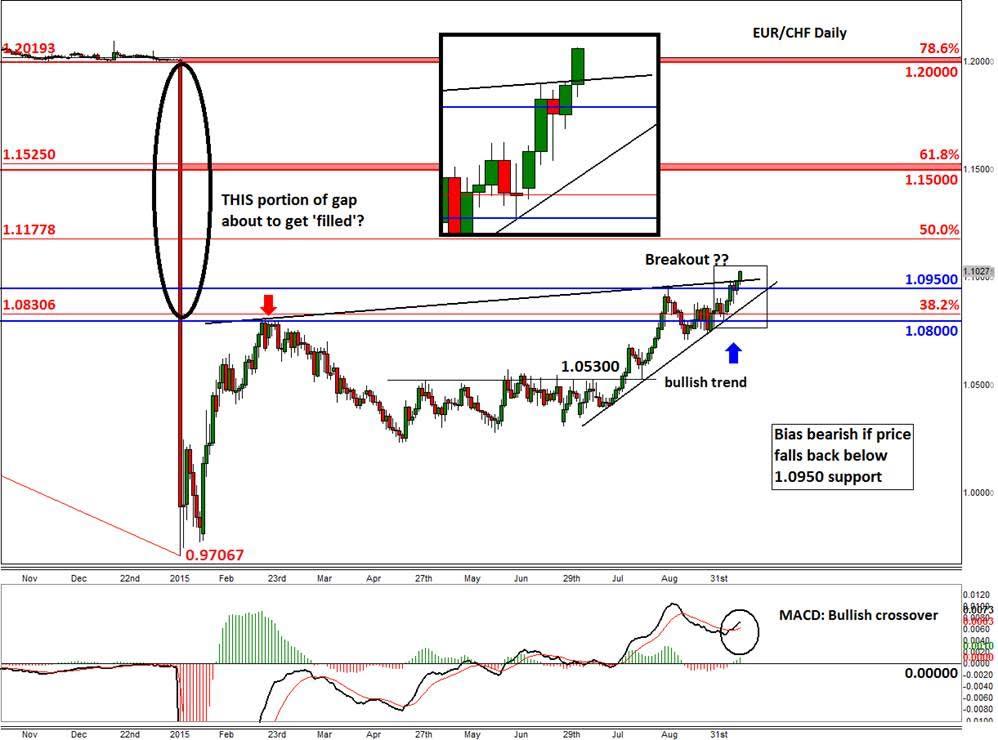![]()
The EUR/CHF has broken above 1.10 handle for the first time since THAT disastrous day in January when the Swiss National Bank (SNB) abandoned its policy of keeping the pair above the 1.20 floor. That decision saw the EUR/CHF plummet to as low as 0.97 before it starting to recover and then hit a ceiling around 1.0800 in February which led to a drop back below 1.03 by April.
But it looks like the SNB’s decision is slowly working its magic as the franc has been steadily falling since the start of the summer and the EUR/CHF pair is now up for the fourth consecutive month. Due to the negative deposit rates, Swiss investors have been moving cash from their savings into other assets such as equities and countries elsewhere interest rates are comparatively higher. Although interest rates in the Eurozone are also effectively zero, the apparent unwinding of long equity positions is continuing to support the euro, which many believe had been used as a funding currency in the recent past. Thus, if the equity markets continue to drop then the EUR/CHF may actually rise further rather than doing what it ‘should’ which is to fall (the CHF is a traditionally a safe haven currency).
From a technical point of view, the EUR/CHF has potentially made a major breakthrough. As can be seen from the chart, it has broken out of a long-term consolidation pattern and the breakout is confirmed by momentum indicator MACD which has crossed over the signal line. In fact, the break had already been established some time ago when it first climbed out of another consolidation pattern around 1.0530, a level which later turned into a significant support and led to a rally to 1.0950. A bullish trend line is now in place and for as long as the bulls defend it, the path of least resistance would remain to the upside. In short-term, the bulls will need to hold their ground ideally above the old resistance level of 1.0950; failure to do so could see the return of the sellers.
Assuming today’s breakout will be confirmed by a decisive close above the 1.10 handle, there are no immediate resistance levels that could stand on the way of the rally apart from the Fibonacci extension levels of the most recent downward move from 1.0960 to 1.0710 (not drawn on the chart). The 127.2 and 161.8 extension levels of this swing come in or around 1.1025 and 1.1115 respectively.
Longer-term traders will want to keep a close eye on the Fibonacci retracement levels of the downswing from the May 2013 high of 1.2650, at 1.1175 (50%), 1.1525 (61.8%) and 1.2020 (78.6%). Admittedly, the 61.8 and 78.6 per cent Fibonacci levels are some distance away from the current market price, so it may require some fundamental event to get there. But if we do get to those levels it will not be in a straight line and could take several months.
Nevertheless, the path of least resistance is now clearly to the upside and given the nature of the EUR/CHF’s drop in January, there’s effectively a big void below 1.2000 which may now get ‘filled’ – similar, for example, to how the Swiss Market Index (SMI) of 20 largest and most liquid Switzerland-listed stocks filled its own gap in the first half of this year, before tumbling once more.
Trading leveraged products such as FX, CFDs and Spread Bets carry a high level of risk which means you could lose your capital and is therefore not suitable for all investors. All of this website’s contents and information provided by Fawad Razaqzada elsewhere, such as on telegram and other social channels, including news, opinions, market analyses, trade ideas, trade signals or other information are solely provided as general market commentary and do not constitute a recommendation or investment advice. Please ensure you fully understand the risks involved by reading our disclaimer, terms and policies.
Recommended Content
Editors’ Picks
EUR/USD edges lower toward 1.0700 post-US PCE

EUR/USD stays under modest bearish pressure but manages to hold above 1.0700 in the American session on Friday. The US Dollar (USD) gathers strength against its rivals after the stronger-than-forecast PCE inflation data, not allowing the pair to gain traction.
GBP/USD retreats to 1.2500 on renewed USD strength

GBP/USD lost its traction and turned negative on the day near 1.2500. Following the stronger-than-expected PCE inflation readings from the US, the USD stays resilient and makes it difficult for the pair to gather recovery momentum.
Gold struggles to hold above $2,350 following US inflation

Gold turned south and declined toward $2,340, erasing a large portion of its daily gains, as the USD benefited from PCE inflation data. The benchmark 10-year US yield, however, stays in negative territory and helps XAU/USD limit its losses.
Bitcoin Weekly Forecast: BTC’s next breakout could propel it to $80,000 Premium

Bitcoin’s recent price consolidation could be nearing its end as technical indicators and on-chain metrics suggest a potential upward breakout. However, this move would not be straightforward and could punish impatient investors.
Week ahead – Hawkish risk as Fed and NFP on tap, Eurozone data eyed too

Fed meets on Wednesday as US inflation stays elevated. Will Friday’s jobs report bring relief or more angst for the markets? Eurozone flash GDP and CPI numbers in focus for the Euro.
